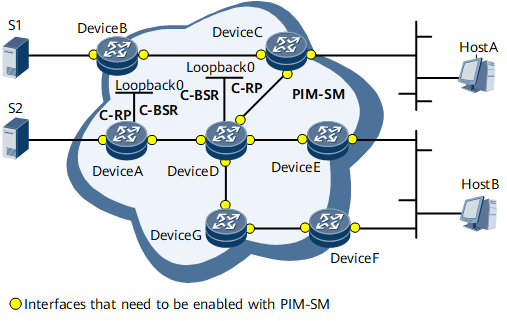PIM Intra-domain
Continuing development of the Internet has led to considerable growth in the types of data, voice, and video information exchanged online. New services, such as VoD and BTV, have emerged and continue to develop. Multicast plays an increasingly important role in the transmission of these services. This section describes Protocol Independent Multicast-Sparse Mode (PIM-SM) intra-domain networking.
Figure 1 shows a large-scale network with multicast services deployed. An IGP has been deployed, and each network segment route is reachable. Group members are distributed sparsely. Users on the network require VoD services, but network bandwidth resources are limited.
Implementation Solution
As shown in Figure 1, Host A and Host B are multicast information receivers, each located on a different leaf network. The hosts receive VoD information in multicast mode. PIM-SM is used in the entire PIM domain. Device B is connected to multicast source S1. Device A is connected to multicast source S2. Device C is connected to Host A. Devices E and F are connected to Host B.
PIM-SM is enabled on all router interfaces.
As shown in Figure 1, multicast sources are densely distributed. Candidate-Rendezvous Points (C-RPs) can be deployed on devices close to the multicast sources. Loopback 0 interfaces on Devices A and D are configured as candidate-bootstrap routers (C-BSRs) and C-RPs. A BSR is elected among the C-BSRs. An RP is elected among the C-RPs.
The RP deployment guidelines are as follows:Static RPs are recommended on small-/medium-sized networks because a small-/medium-sized network is stable and has low forwarding requirements for an RP.
If there is only one multicast source on the network, setting the device directly connected to the multicast source as a static RP is recommended. The source's designated router (DR) also functions as the RP and does not need to register with the RP.
When a static RP is used, all routers, including the RP, must have the same information about the RP and the multicast groups that the RP serves.
- Dynamic RPs are recommended on large-scale networks because dynamic RPs are easy to maintain and provide high reliability.
Dynamic RP
If multiple multicast sources are densely distributed on the network, configuring core devices close to the multicast sources as C-RPs is recommended.
If multiple users are densely distributed on the network, configuring core devices close to the users as C-RPs is recommended.
Anycast-RP
Small-scale network: A static RP is recommended.
Large-scale network: Configuring a BSR to elect an RP is recommended to facilitate RP maintenance.

To ensure RP information consistency, do not configure static RPs on some routers but dynamic RPs on other routers in the same PIM domain.
IGMP is run between Device C and Host A and between Device E, Device F, and Host B.
When configuring IGMP on router interfaces, ensure that interface parameters are consistent. All routers connected to the same network must run the same IGMP version (IGMPv2 is recommended) and be configured with the same parameter values, such as the interval at which IGMP Query messages are sent and holdtime of memberships. Otherwise, IGMP group memberships on different routers will be inconsistent.
Hosts A and B send Join messages to the RP to require information from the multicast source.

Configuring interfaces on network edge devices to statically join all multicast groups is recommended to increase the speed for changing channels and to provide a stable viewing environment for users.
